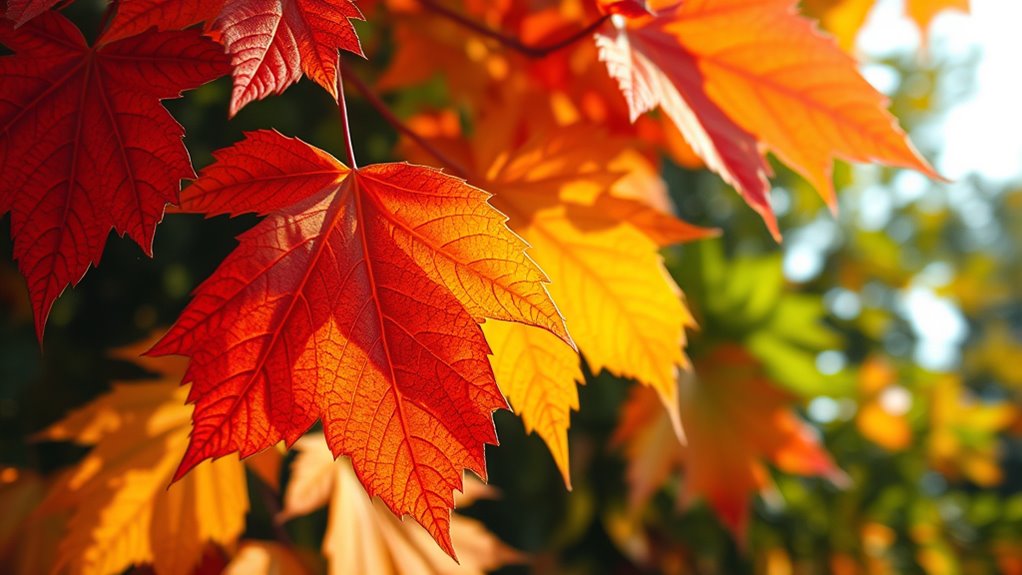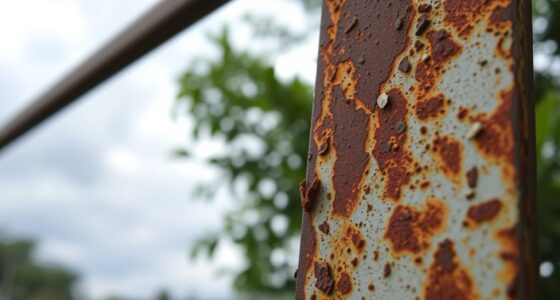In autumn, your leaves change color because chlorophyll, the pigment making them green, breaks down as days get shorter and temperatures drop. This reveals underlying pigments called carotenoids, which show yellow and orange hues, and the new production of anthocyanins that give reds and purples. Environmental cues like sunlight and temperature influence these chemical reactions, creating vibrant displays. To understand the fascinating chemistry behind these colorful shifts, keep exploring how these pigments work together.
Key Takeaways
- Chlorophyll breaks down as days shorten, revealing underlying pigments like carotenoids and anthocyanins.
- Carotenoids produce yellow and orange hues, always present but masked by chlorophyll during the growing season.
- Anthocyanins form in response to sugar buildup and environmental stress, creating red and purple colors.
- Shorter days and cooler nights trigger biochemical changes that influence pigment production and leaf coloration.
- Environmental factors such as light, temperature, and moisture levels significantly affect the timing and vibrancy of fall colors.
The Role of Chlorophyll in Leaf Color

Have you ever wondered why leaves are green? It’s because chlorophyll, the primary green pigment in leaves, absorbs red and blue light from sunlight. This pigment is embedded in chloroplast membranes inside plant cells, where photosynthesis happens. When chlorophyll absorbs sunlight, it converts it into chemical energy, producing oxygen and sugars that fuel plant growth. During the growing season, chlorophyll dominates leaf color, masking other pigments like carotenoids and anthocyanins. It is also chemically unstable and breaks down under bright sunlight, which plants constantly replace. This balance keeps leaves green and highly efficient at photosynthesis. As day length shortens and temperatures drop, chlorophyll production slows, revealing the other pigments and setting the stage for autumn’s vibrant colors. Chlorophyll degradation accelerates as days grow shorter, allowing the vibrant fall colors to emerge.
How Chlorophyll Breaks Down in Autumn

As days grow shorter and nights lengthen in autumn, the timing of chlorophyll breakdown in leaves accelerates. This process begins as decreasing daylight and cooler temperatures signal the plant to halt chlorophyll production. In some species, chlorophyll remains high until about 5–10 days before the leaf falls, then degrades rapidly within one to two weeks. The breakdown involves enzymes breaking down chlorophyll molecules into simpler compounds, which are transported and stored in twigs for reuse. The process can happen gradually or suddenly, depending on the species. Environmental factors like longer nights, cooler temperatures, and weather conditions influence the speed of degradation. Temperature fluctuations also play a significant role in how quickly chlorophyll breaks down. As chlorophyll breaks down, green fades, revealing other pigments and leading to the vibrant autumn colors we see.
The Stability and Persistence of Carotenoids

The stability and persistence of carotenoids in leaves depend heavily on environmental conditions and their chemical properties. Higher temperatures accelerate degradation, with carotenoids losing a significant portion of their pigment over days, especially at 35°C and above. Intense light exposure speeds up breakdown, while darkness helps preserve them. Lipid interactions in cell membranes can also influence carotenoid stability, protecting them from oxidative damage. Additionally, the presence of antioxidants in the leaves can prevent oxidative damage, further influencing carotenoid longevity. Storage conditions matter too; keeping leaves in cool, dark environments minimizes loss. Different carotenoids degrade at varying rates—some more resistant than others. Protective factors like ascorbic acid can slow oxidation. Carotenoids are present year-round but become more visible in autumn as chlorophyll fades. Their chemical structure and interactions with other compounds influence their stability, allowing them to persist long enough to contribute to leaf coloration during the season.
Formation and Function of Anthocyanins

Carotenoids contribute to leaf coloration during autumn, but anthocyanins also play a pivotal role in creating vibrant reds and purples. These pigments form when enzymes like chalcone synthase, chalcone isomerase, and anthocyanidin synthase add sugar molecules to anthocyanidins, derived from phenylalanine and malonyl-CoA. Glycosylation mainly occurs at the 3-OH position, producing stable 3-O-β-glucosides. Different anthocyanins, such as cyanidin, delphinidin, and petunidin, yield red, purple, and blue hues. Functionally, anthocyanins protect plants from excessive sunlight and UV-B radiation, act as antioxidants, and help regulate growth and stress responses. Their production increases under environmental stresses like drought or temperature shifts, contributing to the vivid colors seen in autumn leaves.
Environmental Factors Influencing Leaf Pigmentation

Environmental factors play a crucial role in shaping the vibrant colors of autumn leaves. As days grow shorter, the decreasing daylight and longer nights trigger biochemical changes, breaking down chlorophyll and revealing other pigments. Penetration testing techniques can be used to simulate environmental stressors on plant systems, illustrating how external factors influence pigmentation. Weather conditions, especially temperature and moisture, directly influence leaf coloration. Cool but not freezing nights boost anthocyanin production, resulting in red hues. Adequate moisture keeps colors vibrant, while drought stress can dull them or cause early leaf fall. Bright sunlight enhances pigment synthesis, intensifying reds and oranges. Additionally, nutrient availability, soil quality, and stress from pests or disease affect pigment development. Changes in climate patterns—like warmer temperatures, irregular rainfall, and drought—alter these processes, often leading to less vivid fall displays. Overall, environmental cues are essential in determining the timing, intensity, and duration of autumn leaf colors.
The Chemistry of Key Pigment Molecules

Understanding the chemistry of key pigment molecules helps explain how leaves display their vibrant autumn colors. Chlorophyll, a complex molecule with a magnesium center, absorbs blue and red light, giving leaves their green hue. When days shorten, chlorophyll production halts, and existing molecules break down, revealing other pigments.
Carotenoids, stable yellow and orange pigments, are always present but hidden by chlorophyll during summer. As chlorophyll degrades, carotenoids become visible, producing autumn hues.
In addition, anthocyanins are synthesized in fall in response to excess sugars and sunlight, creating red, purple, and blue shades. These molecules are glycosides with antioxidant properties. Their synthesis and breakdown are regulated by enzymes and environmental cues, shaping the colorful display we associate with fall foliage.
Furthermore, the chemistry of pigment molecules involves complex biochemical pathways that are influenced by environmental factors such as temperature and light, which can alter the intensity and variety of leaf colors during autumn.
The Biological Purpose of Color Changes

The vibrant colors we see in autumn leaves serve functions beyond their visual appeal, playing important roles in the tree’s survival and reproductive strategies. Bright colors, especially reds, attract animals like fruit-eating birds, helping disperse seeds by drawing their attention away from less noticeable fruits. This interaction boosts seed spread and supports forest regeneration.
Additionally, pigments like anthocyanins protect leaves from environmental stress—shielding tissues from excess light and oxidative damage, and reducing freezing injury during cooler nights. As chlorophyll breaks down, trees reabsorb essential nutrients, and color changes signal this process, aiding nutrient recovery and conserving resources for spring.
These adaptive strategies ensure trees survive winter and reproduce successfully, demonstrating that autumn leaf colors serve vital ecological and evolutionary functions.
How Pigments Unmask During the Fall

As autumn days grow shorter and nights longer, the production of chlorophyll in leaves slows down and eventually stops. The existing chlorophyll molecules break down and are destroyed, causing the green color to fade.
When this happens, other pigments that were present but masked—mainly carotenoids and anthocyanins—become visible. Carotenoids, responsible for yellow and orange hues, are always in the leaf but hidden by chlorophyll. As chlorophyll disappears, these bright colors shine through.
Meanwhile, anthocyanins are produced anew in response to trapped sugars and changes in leaf chemistry. They reflect red and purple hues, adding vibrancy to fall scenery.
The formation of a leaf abscission layer also helps trap sugars, promoting pigment changes and preparing the leaf for eventual fall. Pigment chemistry plays a crucial role in the stunning transformations observed during this seasonal change.
The Significance of Seasonal and Geographic Variations

Seasonal and geographic variations markedly influence the timing, intensity, and appearance of autumn leaf colors. You’ll notice the change usually occurs between mid-September and early November, but weather conditions like heat and drought can cause leaves to turn brown or fall earlier.
Shorter days and cooler nights trigger pigment changes, with temperature fluctuations affecting vibrancy. Regionally, colors can vary greatly—some areas display vivid reds and oranges, while others are more muted.
Urban heat islands often delay color shifts compared to rural spots. Environmental factors such as soil quality, sunlight, and climate zones also impact leaf health and pigment production.
These variations aren’t just aesthetic; they affect tourism, local economies, and ecological awareness, highlighting the importance of understanding how geography and seasons shape autumn’s spectacular display.
Additionally, home environment factors like urban heat effects can influence the timing and intensity of leaf color changes, illustrating how local conditions impact natural seasonal phenomena.
Frequently Asked Questions
How Do Different Tree Species Vary in Their Autumn Leaf Colors?
You’ll notice that different tree species display a variety of autumn leaf colors because of their unique pigment compositions. Some trees, like maples, produce vibrant reds and oranges thanks to high anthocyanins and carotenoids.
Others, like ginkgo and hickories, mainly turn yellow due to carotenoids. Species like black tupelo can show multiple colors in one season because they produce diverse pigments, creating stunning, varied fall displays.
Can Environmental Stress Affect the Pigment Change Process?
You might think environmental stress only harms plants, but it actually influences how your leaves change color. When stressors like heat and drought occur, they alter pigment levels, reducing chlorophyll and boosting protective pigments like anthocyanins and carotenoids.
This process not only creates vibrant reds, oranges, and yellows but also helps trees survive stress. So, environmental challenges shape the beautiful autumn display you enjoy, showcasing nature’s resilience and adaptation.
Why Do Some Leaves Turn Red While Others Turn Yellow or Orange?
You notice some leaves turn red, while others become yellow or orange, because different pigments are responsible.
Red colors come from anthocyanins, which form in response to sugar buildup and light exposure.
Yellow and orange come from carotenoids, which are always present but hidden by chlorophyll during summer.
The species, environmental conditions, and sugar levels influence whether leaves display red, yellow, or orange hues, creating the vibrant autumn landscape you see.
How Long Do Vibrant Fall Colors Typically Last?
Vibrant fall colors usually last about 2 to 3 weeks, peaking in mid-October to early November. You’ll notice the most intense hues during this period, especially when weather conditions are ideal—cool, frost-free nights and sunny days.
However, rain, wind, or early frost can shorten this window. The timing varies by region and elevation, so your local display might be slightly earlier or later.
Are There Any Health Benefits Linked to Autumn Leaf Pigments?
You might be surprised to learn that autumn leaf pigments offer several health benefits. Anthocyanins act as powerful antioxidants, helping delay aging and repair nerves.
Carotenoids, like beta-carotene, boost your immune system, protect your vision, and improve skin health.
Consuming these pigments from natural sources can support cellular health, reduce inflammation, and promote overall well-being.
Incorporating foods rich in these pigments can naturally enhance your health and longevity.
Conclusion
As autumn arrives, you’ll notice vibrant leaf colors thanks to the breakdown of chlorophyll and the prominence of carotenoids and anthocyanins. Did you know that some trees, like the scarlet oak, can produce over 50 different shades? These color changes aren’t just beautiful—they also protect leaves and prepare trees for winter. So next time you admire fall foliage, remember it’s a stunning display of chemistry at work, revealing nature’s intricate and adaptive design.









